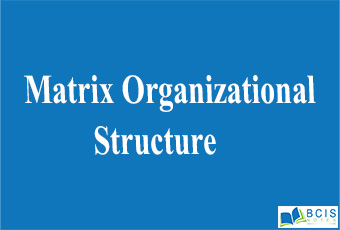
Matrix Organizational Structure
A matrix organizational structure is a company structure in which the reporting relationships are set up as a grid, or matrix, rather than in the traditional hierarchy. In other words, employees have dual reporting relationships – generally to both a functional manager and a product manager.
The advantages are given below:
One of the biggest pros of using a matrix organizational structure is that it allows the sharing of highly skilled resources between functional units and projects. Communications are open, which helps knowledge move throughout the organization with less obstruction. Because the matrix organizational structure fosters better communications, it makes the normal boundaries between groups more porous, which allows for more collaboration and an integrated, more dynamic organization.
This structure can serve as a great boon for employees who are looking to widen their experience and skillsets. They can be part of many different aspects of various projects. It puts them in an environment that facilitates learning and gives them an opportunity to grow professionally.
Plus, the functional departments have highly skilled people, and those people are available to help the project team if needed. This creates a pool of valuable resources that can be dipped into and provides more flexibility to resolve issues without having to source new resources.
Furthermore, efficiencies are enhanced, and teams remain loyal because the structure provides a more stable environment where job security is strengthened. People work harder and have more buy-in to projects when they feel the rug isn’t going to get pulled out from under them.
Points:
- Clear articulation of project objectives
- Workable way of integrating project objectives with functional objectives
- Efficient use of limited human resources
- Rapid (often interdisciplinary) information flow through the project
- Retention of expert teams through the life of the project
- Rapid dispersion of team members back into the functional organization upon project completion without organizational disruption
- Project management trains managers to become leaders in the functional organization
- Project structures develop team spirit and high morale
- Possibility of conflicts arising during the project carrying over to functional management
The disadvantages are given below:
There can be some confusion when a team member is subject to two managers. That can also create unnecessary conflict. This is especially true if both managers have equal authority.
Then there is the functional manager and project manager. There can be some sparks flying between these two managers in terms of what they believe to be the authority in the organization. That confusion can show up with team members, too, if their roles and responsibilities aren’t clearly defined. And that confusion can lead to conflict if resources are hard to come by and competing managers are fighting for them.
There are a lot of managers in a matrix organizational structure, which is not to everyone’s liking. And there can be a financial downside to that too. Having more people in managerial positions is going to have an impact on the organization’s bottom line.
Team members can feel the strain of working in a matrix organizational structure, in that their workload can be heavy. Often, they’re tasked with their regular assignments and then additional work, which can lead to burnout or some tasks being ignored.
Finally, there’s the overall expense of the matrix organizational structure. This goes beyond having multiple managers but also the added expense of keeping on resources that might not be used all the time.
Not that some of these disadvantages can’t be overcome. They just require being cognizant of the stress points and working more cooperatively towards relieving them.
Points:
- Two-boss problems, leaving project members caught in the middle
- Project members playing bosses against one another
- Increases organizational complexity
- The requirement for a high degree of cooperation between functional and project management
- Potential for conflicting management directives
- The difficulty of establishing priorities suiting both functional and project management
- Possible slowdowns in management reaction to events when two structures required for the solution
- The possible structural collapse in “crunch time”
- Increase in management overhead costs
You may also like Departmentalization

Leave a Reply